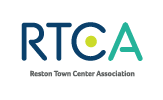The idea of a community “downtown” was part of the original plan for Reston when Robert E. Simon, Reston’s founder, bought in 1964 the land that would become Reston.
Today Reston Town Center is a bustling and prosperous downtown for the community of Reston and a destination for the entire region. But its success was anything but a foregone conclusion when it was originally envisioned. The idea that a dense, urban, mixed-use downtown could be built in the middle of suburbia — at a time when malls and sprawling living and working spaces were the paradigm — was a risky proposition. Let’s see how it came to be.
The Beginning
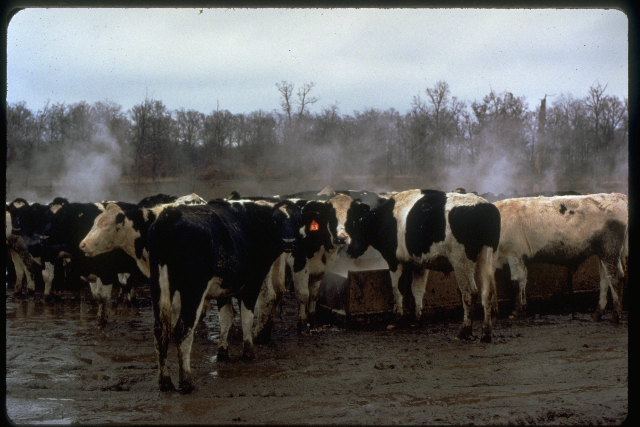 It’s hard to imagine that this cow pasture was located on what is now the core of Reston Town Center. As this area emerged as an important tech and employment center, and with the opening of the Dulles Toll Road in 1984 (better connecting the region’s international airport with the Capital Beltway and Washington, D.C.), the ingredients were in place for the cow pasture to give way to what would become the downtown.
It’s hard to imagine that this cow pasture was located on what is now the core of Reston Town Center. As this area emerged as an important tech and employment center, and with the opening of the Dulles Toll Road in 1984 (better connecting the region’s international airport with the Capital Beltway and Washington, D.C.), the ingredients were in place for the cow pasture to give way to what would become the downtown.
The Concept
To create what would become the Urban Core, the original Town Center planners took a long-term view. Key elements included working with Fairfax County to design flexible zoning (and a new zoning concept), phasing development, and creating a grid of streets (uncommon in suburbia at the time but a part of the urban experience that was intended). Other critical aspects of the vision included creating a complete, mixed-use experience, augmented with walkable streets, storefronts, offices, trees, sidewalks, and open space — all designed to give a feeling of “place.” Special meeting and gathering spaces were essential to the vision, starting with the iconic Mercury Fountain Plaza (about which Bob Simon remarked in the terrific film celebrating Reston’s 50th Anniversary, Another Way of Living: The Story of Reston, Virginia, “I am hopeful that Fountain Square will be a model for hundreds of others around the country, because I think it is just about perfect.”). That near-perfection would be complemented by Hyatt Park, various pocket parks, and eventually by Reston Town Square Park at the other end of Market Street (and a new, and the largest, urban plaza still to come as the adjacent Metro lots are developed). High-quality building materials and design details were insisted upon to help create a memorable and unique identity.
The plan also benefitted in the early years from having developers who had both a sense of stewardship and also the patience and “deep pockets” to develop the property on pace with the market but without compromising the plan. Mobil Oil, as the primary investor, provided the financial stability in the first decade, and Reston Land Corporation saw the project through a major recession, continuing the commitment to the public experience, quality development, and community building.
Realization of the Vision
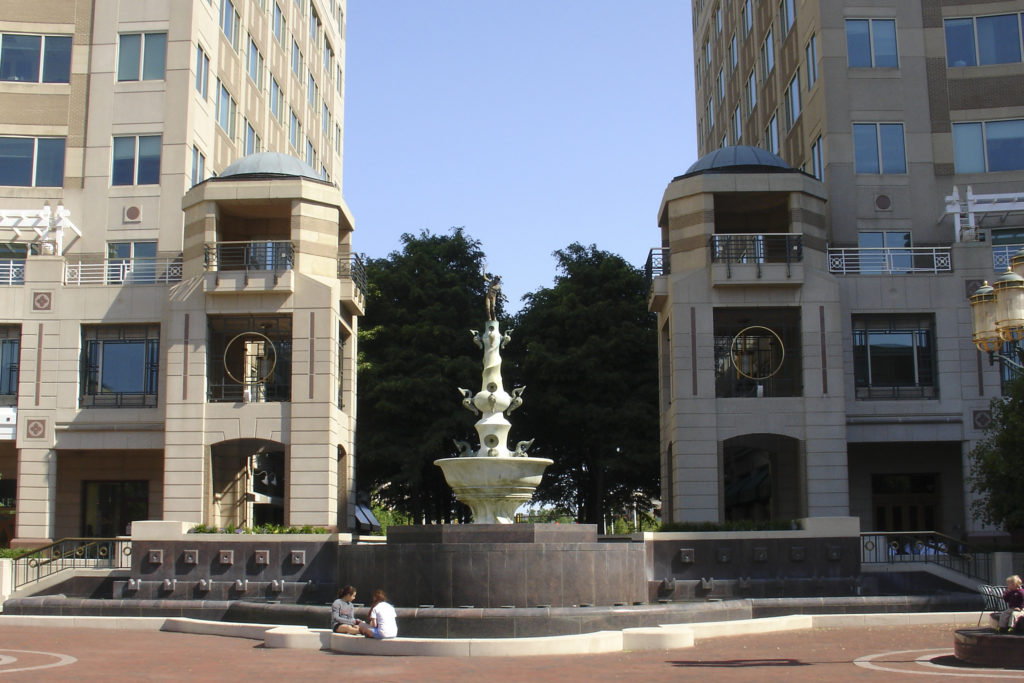
The grand opening for the first phase of the Urban Core took place in the fall of 1990 with the unveiling of the Mercury Fountain, by noted international sculptor, St. Clair Cemin. At the outset, Market Street, the spine of the urban experience, was activated with retail, a movie theater, a Clyde’s restaurant, and the Hyatt Regency Hotel, core ingredients of the initial success. Hundreds of community events during those first years drew many thousands of visitors who began to feel and see Reston Town Center as their downtown and an increasingly different and special place. Despite a national recession as its first decade came to a close, Town Center remained able to attract strong local, national, and international businesses to its footprint, and growth continued.
The Town Center’s second decade saw the vision, dedication, and talent of the next generation of developers carry out and expand upon the plan. These included Boston Properties, who built out the remainder of the Urban Core with high-rise office, quality retail, and a diverse restaurant scene; Lerner Enterprises, who built out Spectrum; and what became JBG Smith, developer of RTC West. The perspective they brought also included the foresight to pivot as conditions demanded. What was the third phase of development of the Urban Core (between Explorer Street and Town Center Parkway) was originally planned as exclusively commercial. But as the market changed, and it became clear that a stronger residential component was needed to complete a dynamic, mixed-use downtown, the plan was adapted to convert that third phase to essentially residential with some ground-floor retail, all surrounding what would become Reston Town Square Park. That and other changes proved prescient and activated RTC in new ways.
Today the Urban Core is full of retail stores and restaurants with national reputations, offices occupied by what reads like a Who’s Who of successful local, national, and international companies (RTC is today one of the most important employment centers in the region), and high-rise condominiums, apartments, and offices overlooking stylish urban parks and plazas. Beyond the Urban Core, RTC is home to a major regional medical center (Reston Hospital, which opened in 1986), growing mixed-use spaces at Spectrum and RTC West, individually owned commercial properties that include Target, Oracle, and Harris Teeter, a highly thought of YMCA, and diverse and growing residential neighborhoods that offer condo, townhome, and apartment living that are all within walking distance of the Town Center’s great amenities and employment opportunities.
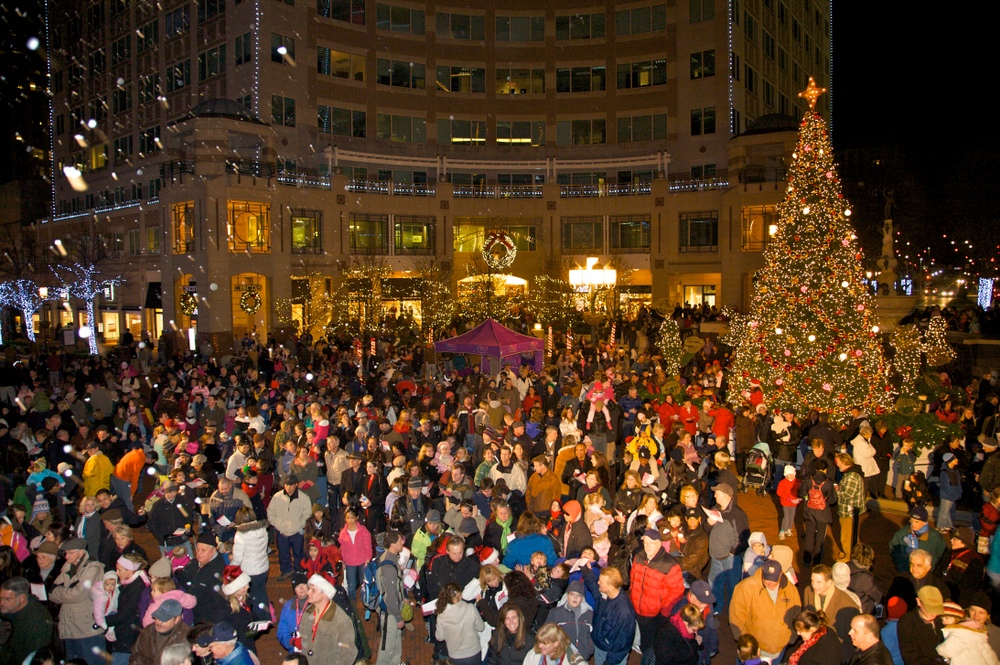
Building Community and a Rich Cultural Proposition
From the very beginning, the builders of Town Center wanted to be clear that this was a community center, not just another shopping center. Once the first buildings and streets were open, community events of all shapes and sizes were organized and offered throughout the year, from concerts to festivals to walks, runs, and other charitable fundraisers that continue to raise hundreds of thousands of dollars each year for non-profits. This remains an essential part of RTCA’s mission, to help animate the RTC experience with a full calendar of community and cultural programming that enriches and inspires (with many programs presented in partnership with our wonderful cultural partners, chief among them Reston Community Center).
Location and support of an arts center (originally the Greater Reston Arts Center, now rebranded and reimagined as Tephra Institute of Contemporary Art, one of the region’s leading contemporary art centers) was part of the original plan, and RTCA has also provided extensive support for a robust sculptural footprint that, in recent years, has included Reston Rondo in Hyatt Park and the 50′, steel, surrealist sculpture, Buoyant Force, in Town Square Park. Through another of RTCA’s cultural partners, Public Art Reston (of which RTCA is a founding member), one can take a self-guided tour of all the wonderful public art in Town Center.
All of these efforts earned RTCA the Arts Philanthropy Award from ArtsFairfax in 2021. That cultural proposition not only draws tens of thousands of visitors every year, but also differentiates Reston Town Center from ordinary office parks or other places claiming “town center”-like status. It helps drive world-class employers here, who see this as a dynamic place where they can recruit and retain the best and brightest. And just as importantly, as residential began to fill both in and around the Urban Core, the community programming was and remains essential to creating a sense of neighborhood. Residents can not only walk to shops or their jobs and meet friends for coffee or dine at the diverse array of restaurants, but they can also attend or volunteer with the cultural programming or charitable events that reflect the broad diversity of the community of which we are a part. And they can enjoy that complete Town Center lifestyle all within walking distances of their homes.
The Future
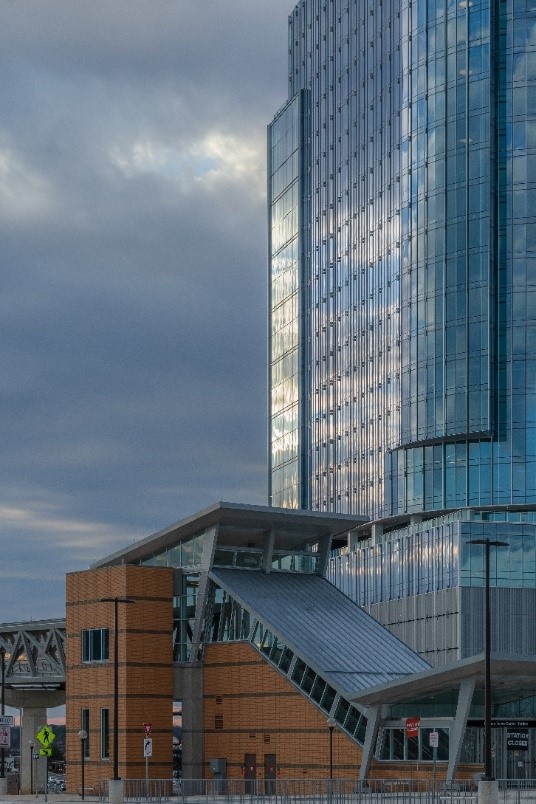
The first three decades of Town Center’s growth established the experiment as not only an unqualified success, but one others now seek to replicate. RTCA has entertained international delegations (from as far away as Japan, Korea, and Australia, as well as growing areas in the United States), who visit to try to understand the ingredients for success and how they can build their own “Reston Town Center.” But Reston Town Center is anything but static; it continues to evolve and grow. The opening of Metro’s Silver Line in 2014, and of the Reston Town Center Metro Station in November 2022, has launched a new and dynamic period of change and redevelopment, what we sometimes refer to as RTC 2.0.
To help maximize the massive public-private investment in rail, and ensure that mixed-use, transit-oriented development results, zoning was changed to allow (and require) the building of residential along the Dulles Toll Road and in the transit station areas (areas that were originally zoned exclusively commercial). Consequently, exciting plans are in place to redevelop the lots to the north and directly across the RTC Metro Station into dynamic, mixed-use spaces that will combine office, residential, hotel, and other uses. There will be vehicular and pedestrian connections that will tie together the existing Urban Core and this extension. A central urban plaza, much larger than what now exists in the Urban Core, is a key orienting feature of the plan, as is a skywalk that will take Metro travelers over Sunset Hills Road and drop them into this exciting, dynamic space. Retail and public art, as well as a proffered Reston art center (TBD), are all core elements of the plan. In total, on the two lots across from the Metro, the plans call for approximately 2Msf of office, 2Msf of residential, 500Ksf of hotel, and almost 200Ksf of retail. By design, these will be the densest lots in all of Reston and will dramatically expand the RTC experience.
And it is not just those lots that will redevelop. In around 2020, Reston Hospital underwent an important expansion. Plans have already been approved to significantly redevelop both RTC West (with the addition of two office and two residential towers) and Spectrum (that will essentially raise everything on that property and recreate it as a mixed-use space with predominantly residential, but also office, hotel, retail, and open spaces). Overall, in the coming couple of decades, Reston Town Center will more than double in size and become an even more compelling regional destination, employment center, and desired residential neighborhood.
RTCA now operates linkRTC, a free shuttle service to help tie this all together. Bike parking (including innovative, secure bike parking) and Capital Bikeshare facilities have been added, and preserving RTC as a walkable environment is paramount. The WOD Trail, an essential community amenity, will be incorporated into the redevelopment, all of which will have a strong focus on LEED and other environmentally sustainable standards.
For those of us who live, work, and/or visit here, RTC’s first thirty years were pretty astounding. The next thirty promise to be just as or more exciting. We look forward to seeing you at Reston Town Center.
Learn more about Reston Town Center
There are many excellent publications that explore Reston Town Center, its history, and its success, including Reston Town Center: A Downtown for the 21st Century, Alan Ward (ed.), Washington, DC: Academy Press, 2006. Some of these resources can be found (and purchased) with a visit to the Reston Museum.
